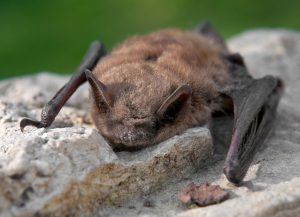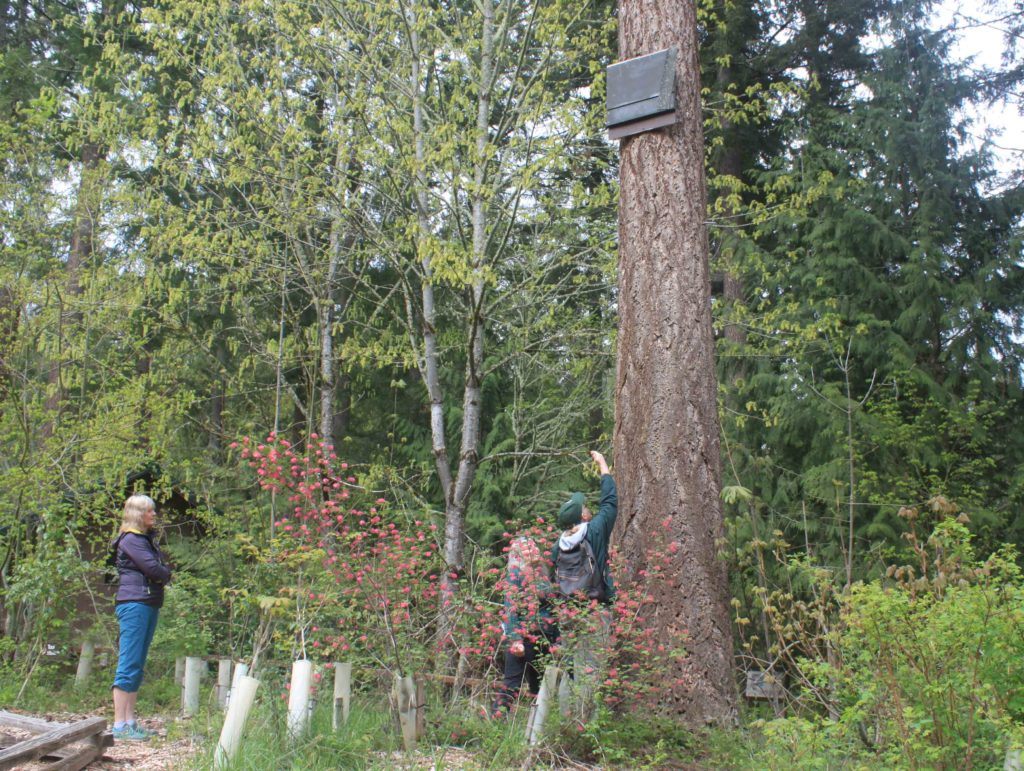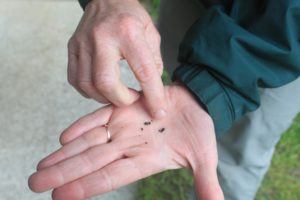Some was sprinkled around the base of a tree. More was scattered over the floor of the tram garage.
But it was just outside one of the veterinary clinics, under a wide overhanging awning, that Michelle Tirhi got really excited.
“Look at all that!” she exclaimed, sweeping her eyes around the concrete floor. “And it’s all fresh! We could just scoop up some right now.”
Bending down, she picked up a tiny black sliver the size and shape of a rice grain and held it up triumphantly.
Bat poop.
Or guano, to be precise. Tirhi, the District II wildlife biologist for the Washington Department of Fish and Wildlife (WDFW), was on the last stop of a tour around Northwest Trek to find fresh bat guano, accompanied by Trek conservation engagement staff Karen Povey and Rachael Mueller.
Why bat poop? Because white-nose syndrome has hit Washington bats, and WDFW wants to study it.
Deadly disease

White-nose syndrome is a disease that has spread quickly in eastern North America over the last decade, killing over six million bats and wiping out entire colonies. A fungus that grows on the noses, wings and ears of bats during winter hibernation, it gets its name from the white, fuzzy appearance it may give the suffering animals. Invading deep skin tissues, it irritates the bats as they hibernate, which burns through the fat reserves they need to survive.
And now it’s here in Western Washington. After the first diseased bat was found by hikers near North Bend in March 2016 the department acted quickly, spreading out around the site to study local bat colonies for signs of the fungus.
But it’s tricky to spot. Washington bats are difficult to find during winter – when the disease spreads – as no-one quite knows where they hibernate. By summer, the fungus spores have died off from the heat. So Tirhi swings into gear in spring, partnering with bat-populated sites around Pierce and Thurston counties to catch the tiny winged animals as they return to their summer roosts.
And to spot the fungus? Well, that’s where the guano comes in.
Hunting bat poop
“Our biggest roost is in this breezeway,” explains Mueller, standing near the entrance to the wildlife park. “I was actually training volunteers on our regular bat boxes in the trees when I heard bats overhead. I realized they were roosting right here.”
Washington bats can fit into the tiniest of crevices to roost. They love places high up, relatively undisturbed, and preferably south-facing to capture heat. An extra section of roof gave them the perfect spot – and Tirhi the perfect ledge, high up and away from visitors, to attach a meshed tray to collect droppings for the lab.
(The fungus stays on guano for several weeks, allowing biologists to find out if local bats are healthy without disturbing their roosts.)
But before setting up the tray, she drove around with Mueller and Povey to the garage where the trams that take visitors around the Free-Roaming Area are parked at night – and discovered a treasure trove of guano.
“Look!” she cried, pointing to a scatter of tiny black pellets at either end of the wide doorway. “This is super-easy! We can just put down a tarp here and a tarp there and collect it really easily.”
And when Muelller, who counts the bats with volunteers, estimated the garage to be home to around 90 bats, with the same number in the breezeway, Tirhi was visibly thrilled.
“These are huge colonies for Washington,” she said. “This might be the second-largest in the region. Our bats are more solitary than in the South and East coasts, where they have colonies of thousands. And there are so few places around here where we actually know bats to be that this is really valuable.”

Tiny but essential
Bats might be tiny, and they might mess up a garage. But they’re essential to ecosystems around the world. They consume insects that would otherwise damage valuable crops and forests or threaten human health. And some are pollinators, helping grow our food and disperse seeds.
So far, nobody has found a cure for white-nose syndrome, or even a way to prevent it from spreading, other than ensuring humans (or pets) don’t inadvertently carry the fungus on clothing from infected caves and mines.
That’s why scientists like Tirhi are enlisting help to collect guano, send it to a lab for testing and study the disease and, if possible, stop the spread before it devastates Western bats too.

Guano, guano, guano
But Mueller wasn’t done yet. Driving Tirhi around to the veterinary clinic area, she led the way to a small building where the vet technicians were having to sweep bat guano every other day.
Sure enough, there were the little black pellets – and overhead, the chirruping, high-pitched sound of slightly annoyed bats.
“Wonderful!” said Tirhi, picking up a pellet.
“They look like mouse poop,” observed Mueller.
“Ah, but look – they sparkle!” Tirhi answered. “That’s because of the chitin in the insects these bats eat. Mice don’t eat as many things with exoskeletons.”
And sure enough, as she turned the little pellet to the sunlight, it glittered.
To some, just bat poop. But to biologists, a kind of gold treasure that would, maybe, yield the secret of saving our bats.
– Rosemary Ponnekanti, Northwest Trek
NOTE: If you ever see sick or dead bats, please report them to the Washington Department of Fish and Wildlife at 360-902-2515 or wdfw.wa.gov/bats.
Never handle a live bat with your bare hands. White-nose syndrome does not pose a threat to humans, pets or other animals.